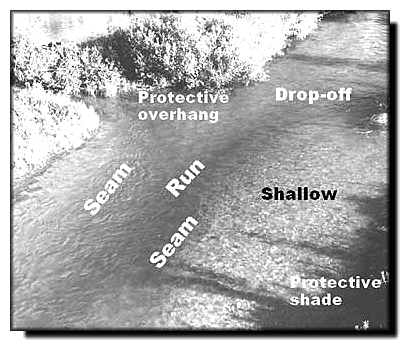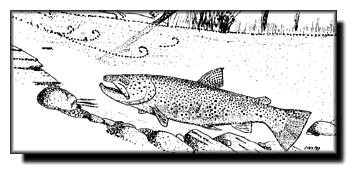Reading trout water
By Clive Schaupmeyer
Adapted from "The Essential Guide to Fly-Fishing" by the author
Figuring out the fishy parts of a stream is what we call "reading
the water." You can learn a lot about reading water by taking a class on
fly-fishing. And you will learn from experience. When trout are rising,
you know where they are. It becomes a bit trickier if they are feeding
down below and you can't see them. When you are on the water, pay attention.
Ask yourself: If I were a trout, where would I hold? Where will I be protected
from the current, from predators and have access to a steady supply of
food?

Polarized sunglasses are extremely useful for reading trout streams
and occasionally helping you actually see fish in the water. These special
lenses eliminate most of the surface glare and often allow you to look
into the water and see structural variations that create the different
types of water that hide fish.
Within the four general types of water
(see last week's article) trout tend to hold where they are
safe from predators, where the current isn't too strong, and
where there is a ready supply of food. Any place
in a river that can provide all three at the same time is a prime holding
spot, or prime lie. When there is intensive insect activity (either on
the surface or below), trout will let their guard down and move into shallow
water or to the surface. They often move out of the runs into shallow water
as night falls.
Trout tend to hold at the bottom of deeper runs, just below dropoffs,
and behind rocks or other obstructions in the stream. They also hold under
streamside vegetation or in undercut banks.

Large boulders within a riffle or run form what we call pocket
water. Trout hold in front and behind rocks where the water speed is buffered.
Conflicting currents make dry-fly and nymph fishing difficult in pocket
water.

Seams are transition layers between two sections of water flowing
at different speeds. There is often a noticeable seam between shallow,
slower water and a fast run. Trout often hold in the slower water and have
the added benefit of a nearby steady flow of food passing by.
Back eddies are also favorite holding spots. Again, the water
current is usually slow, and there is a nearby food supply in the faster
water to the outside of the eddy. During a hatch, insects often get caught
up in the slow swirling currents in a back eddy. It is not uncommon to
see trout noses sipping bugs in the back eddy foam. Because of the conflicting
currents, back eddies are usually difficult to fish. ~ Clive Schaupmeyer
Our Man In Canada Archives
|

 February 1st, 1999
February 1st, 1999



 February 1st, 1999
February 1st, 1999


